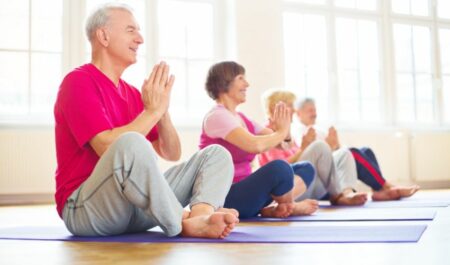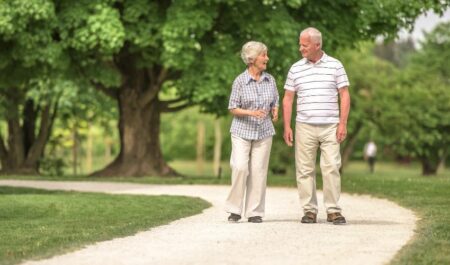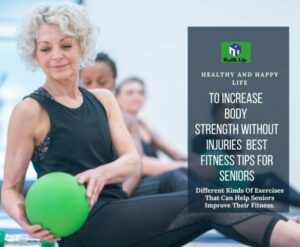There is a wide variety of physical activity that can be undertaken by senior citizens who are interested in maintaining their fitness levels. However, there is such a wide variety of workouts to choose from that it frequently leads to a great deal of confusion. This is because everyone tends to say that their particular exercise routine is the most effective.
There is a plethora of information regarding different forms of exercise for seniors available on the internet; however, very little of it is applicable in real life. The workouts that are prescribed for older adults are, for the most part, far too rigorous and unachievable.
They want to conduct activities that will help them with their gait balance, postural stability, and reduce joint stiffness. In general, seniors want to do exercises for functional advantages rather than gaining muscle. What are some good activities that can help seniors improve their fitness? Continue reading for some useful advice.

1. Consultation From Primary Care Physician Before Start.
Before beginning any kind of fitness program, senior citizens who have not previously engaged in physical activity should first get a checkup from their primary care physician or another qualified medical professional. You must ensure that your body is capable of withstanding the strain that is caused by exercise. In the event that you have any health issues, the healthcare practitioner may advise certain workouts and follow-up for you to complete in order to secure your safety.
2. Enjoyment.
To get the most out of physical activity as a senior, choose a pursuit that you are almost certain to take pleasure in. This should be your top priority. For instance, if you are just starting out and have never done aerobics before, you might find that the first session leaves you feeling weary and decide that you do not want to do it again.
You need to choose a workout that you enjoy doing and that is appropriate for your present level of fitness so that you will keep doing it and have success with it. Walking is the form of exercise that appeals to the greatest number of people, and it has health advantages that are comparable to those of other forms of physical activity.
3. Are You Making An Effort To Reduce Your Weight?
For elderly people looking to shed some pounds, there is a bevy of physical activity that comes highly suggested. Although some of them are challenging and time-consuming, walking is a good option for those who are just getting started. If you walk every day, five days a week, you can lose 2-3 pounds a month, and in a year, that amounts to nearly 20-30 pounds, which is a significant amount of weight loss.
You may not lose the weight you want to lose within a month, but if you walk every day, five days a week, you can lose that weight. A gradual weight loss is recommended as it is thought to be much healthier. You will also have a better chance of maintaining your weight loss in the years to come.
4. Do Your Joints Hurt?
Most medical professionals would advise you to engage in water-based sports, such as swimming, if you suffer from stiffness and pain in your joints. After warming up your joints by walking about in the water, you can transition to swimming. However, regular participation in activities that take place in water is necessary to reduce joint stiffness.
Additionally, any action that takes place in water provides natural resistance, which is analogous to the experience of working out in a gym with light weights. The activities of water aerobics enhance strength while also improving flexibility and balance, and they put very little pressure on the joints.
5. Exercise Endurance.
Aerobic exercise is the most effective way to build up your body’s capacity to withstand longer bouts of physical activity. Cycling, rowing, jumping rope, playing racquet sports, jogging, and other similar activities are examples of well-known aerobic exercises that can help improve endurance. You should strive to perform aerobic activity for at least seventy-five to one hundred fifty minutes on a weekly basis.
6. Muscle Buildup.
If you want to grow muscle, you will need to lift weights, execute pull-ups and squats, walk up and down stairs, and dip. Additionally, you should walk up and down stairs. If you are of senior age, you want to proceed cautiously with these workouts because it is not unusual for seniors to sustain injuries. The last thing you want to happen when you’re an elderly person is to trip and potentially break a bone.
7. Yoga.

Yoga is a fantastic choice if you’re looking for a low-impact workout that can be done in the comfort of your own home. Yoga has been shown to improve mobility, muscle strength, flexibility, and balance when practiced on a regular basis. A yoga mat and a space to practice the exercise are all that are required to participate in yoga.
This is one of the many benefits of the practice. Your mental health, stress levels, the quality of your sleep, and overall well-being can all improve as a result of practicing yoga, which is another benefit of the practice.
8. Pilates Is Yet Another Sort Of Low-Impact Exercise That Is Appropriate For Senior Citizens.
The principles of Pilates include an emphasis on proper breathing, mental attention, and body alignment. The muscle-building exercise known as Pilates can be performed on mats or with balls. Pilates, when practiced on a regular basis, can be beneficial to seniors in terms of improving balance, strength, and joint flexibility.
9. Walking.
Last but not least, if you are looking for a healthy form of exercise that is appropriate for seniors, walking is your best bet. Every day, you can go at your own pace while you walk, and the quality of your life will still increase as a result. In spite of the fact that the entire public is encouraged to take 10,000 steps each day, elderly people who struggle with arthritis and other health issues might have to settle for less ambitious targets.
There is a significant body of research indicating that regular walking is beneficial to one’s physical and mental health. In addition, walking is an exercise that does not cost anything, can be done virtually anyplace, and does not involve any hassles. Finding a walking companion who shares your goals and aspirations might make the activity more pleasurable for you.

Exercises to Avoid.
Although it is essential for seniors to engage in physical activity, it is equally crucial for them to be aware of the kinds of workouts they should steer clear of. Instead of taking into consideration the needs of older people, the vast majority of workouts are planned with younger people in mind.
These activities can place a significant amount of strain on the body and can lead to major injuries such as falls, muscle tears, joint discomfort, fractures, and muscle damage. Other potential problems include joint pain. In general, senior citizens should steer clear of the following types of workouts:
- Aerobic activity performed at a high intensity.
- Long-distance jogging.
- Sporting activity involving mountain bikes.
- Rock climbing is a sport.
- Triathlons.
- Lift weights and perform exercises such as the bench press, leg press, and squats.
Make It A Group Activity.
Having a workout buddy can help hold you accountable for your program while also making it more fun. If you do decide to play a sport, having a partner can provide some healthy rivalry for you to enjoy. You might also wish to do it in the company of others if you decide to start dancing.
Exercise partners can come from a wide variety of sources, including the workplace and the family. And if you’re having difficulties finding someone to work out with, try going to a community center or a gym in your area to see if they have any group fitness courses that are geared at older adults and give a workout plan for them.
Pay Attention To Your Bodily Cues.
If you are not used to engaging in regular physical activity, you may find that a strenuous workout leaves your muscles feeling a little bit sore. However, physical activity shouldn’t be uncomfortable in any way. Alter your routine immediately if you become aware that a particular technique of moving your body causes you discomfort.
Cut off painful activities. Alternately, you may consider splitting up a larger exercise into several shorter periods that you would perform throughout the day.
Consult a medical professional if any of the following symptoms arise while you are engaging in physical activity:
- Aching in the chest
- Dizziness.
- Uneasy and shallow breaths
- Symptoms such as joint swelling or ongoing pain
- Take it easy for now.
Are you new to exercising? Take it slow and easy at first. One day a week, challenge yourself by going for a brisk walk or jog and stopping when you reach the point where you are no longer comfortable. You should aim to gradually improve the length of your workout as well as the intensity of it each week. You won’t experience feelings of being overwhelmed or disappointed as a result of this, and you’ll be able to truly recognize your progress as time goes on.
When you are first getting used to new exercises, it is essential to go at a pace that is comfortable for you. For instance, if you conduct workouts using only your own body weight or lift weights with incorrect form, you could end up doing more harm than good. Reduce your speed and concentrate on your actions. Do not be afraid to seek the advice of a fitness teacher in order to have your form adjusted or receive pointers on how to perform particular exercises in a secure manner.
